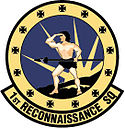1st Bombardment Squadron
| 1st Reconnaissance Squadron | |
|---|---|

|
|
| Active | 5 March 1913–Present |
| Country |
|
| Branch |
|
| Role | Aerial reconnaissance |
| Size | Squadron |
| Part of |
|
| Garrison/HQ | Beale Air Force Base, California |
| Tail Code | "BB" |
| Engagements | Mexico 1916–1917; World War I World War II Vietnam War Global War on Terrorism |
| Commanders | |
| Notable commanders |
Benjamin Delahauf Foulois |
| Insignia | |
| Emblem of the 1st Reconnaissance Squadron |  |
| 100 year anniversary emblem |  |
| Aircraft flown | |
| Reconnaissance | [[Lockheed SR-71A][Lockheed U-2]] RQ-4 Global Hawk (UAV) |
| Trainer | T-38 Talon |
| 1st Aero Squadron | |
|---|---|
| Operations |
Occupation of the Rhineland 21 November 1918-12 May 1919 |
| Victories |
Air Aces: 2
** Pilot (Shared with Observer/Gunner) |
The 1st Reconnaissance Squadron (1 RS) is a United States Air Force squadron, assigned to the 9th Operations Group, Beale Air Force Base, California.
The 1st Reconnaissance Squadron is the United States military's oldest flying unit, first established on 5 March 1913. The squadron has maintained an unbroken heritage of over a century from its founding. Originally organized in anticipation of a potential breach in security along the border between the United States and Mexico, General John J. Pershing directed the 1st Aero Squadron to become the first tactical aviation unit to participate in American military action. The 1st RS has flown 47 different aircraft while being stationed worldwide at 52 locations, including 4 stints at sea.
Since 1922 the 1st Squadron has been associated with the U.S. Army Air Forces (USAAF) 9th Bomb Group and the USAF 9th Reconnaissance Wing, where it continues to be an active flying training unit operating the Lockheed U-2 and the RQ-4 Global Hawk surveillance aircraft.
The 1st Reconnaissance Squadron is responsible for training all High-Altitude Intelligence, Surveillance, and Reconnaissance aircrew for the U-2S Dragon Lady and the RQ-4 Global Hawk. Aircrew members consist of pilots and mission planners for the U-2S, and pilots and sensor operators for the RQ-4. Training for all U-2S pilots includes additional qualification in the T-38A Talon, the companion trainer to the U-2S.
The squadron flies over 5,400 U-2S/T-38A training hours and 2,400 RQ-4 combat support hours annually. This flight training program produces 24 U-2S pilots, 48 RQ-4 pilots, and 36 RQ-4 sensor operators annually.
The Chief Signal officer approved a table of organization for the unit on 7 January 1914, consisting of two companies of eight officers and 45 enlisted men each, and eight aircraft. At the time of its formation, 1st Company consisted of Burgess Model H tractors S.C. No. 9, 24, 25, and 26; while 2nd Company consisted of Curtiss aircraft S.C. No. 2 (a Curtiss Model D), 6 (Curtiss Model E), 22 (Curtiss Model G) and 23 (an aircraft assembled from spare parts for the Curtiss E). The initial composition of the squadron was short three pilots. (According to the U.S. Air Force Historical Research Agency, during this period other training aircraft included at least one example of the Wright Model B, Burgess F, Burgess I-Scout, Burgess J-Scout, and the Martin T.)
...
Wikipedia

